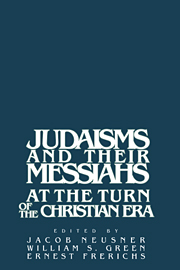Book contents
- Frontmatter
- Contents
- Preface
- List of Contributors
- 1 Introduction: Messiah in Judaism: Rethinking the Question
- 2 Wisdom Makes a Difference: Alternatives to “Messianic” Configurations
- 3 Salvation without and with a Messiah: Developing Beliefs in Writings Ascribed to Enoch
- 4 How the Authors of 1 and 2 Maccabees Treated the “Messianic” Promises
- 5 Messianism in the Maccabean Period
- 6 Waiting for the Messiah: The Spiritual Universe of the Qumran Covenanters
- 7 Philo and Messiah
- 8 Messiah and Gospel
- 9 Christology in Mark's Gospel
- 10 The Question of the Messiah in 4 Ezra
- 11 From Jewish Messianology to Christian Christology: Some Caveats and Perspectives
- 12 Mishnah and Messiah
- General Index
- Index to Biblical and Hermeneutical Texts
Preface
Published online by Cambridge University Press: 08 January 2010
- Frontmatter
- Contents
- Preface
- List of Contributors
- 1 Introduction: Messiah in Judaism: Rethinking the Question
- 2 Wisdom Makes a Difference: Alternatives to “Messianic” Configurations
- 3 Salvation without and with a Messiah: Developing Beliefs in Writings Ascribed to Enoch
- 4 How the Authors of 1 and 2 Maccabees Treated the “Messianic” Promises
- 5 Messianism in the Maccabean Period
- 6 Waiting for the Messiah: The Spiritual Universe of the Qumran Covenanters
- 7 Philo and Messiah
- 8 Messiah and Gospel
- 9 Christology in Mark's Gospel
- 10 The Question of the Messiah in 4 Ezra
- 11 From Jewish Messianology to Christian Christology: Some Caveats and Perspectives
- 12 Mishnah and Messiah
- General Index
- Index to Biblical and Hermeneutical Texts
Summary
A Judaism comprises a world view and a way of life that together come to expression in the social world of a group of Jews. The “Judaisms” of the title therefore constitute several such ways of life and world views addressed to groups of Jews. A Messiah in a Judaism is a man who at the end of history, at the eschaton, will bring salvation to the Israel conceived by the social group addressed by the way of life and world view of that Judaism. Judaisms and their Messiahs at the age of the beginning of Christianity therefore encompass a group of religious systems that form a distinct family, all characterized by two traits: (1) address to “Israel” and (2) reference to diverse passages of the single common holy writing (“Old Testament,” “written Torah”).
In this book we propose to describe how several Judaisms treat the Messiah-theme. These diverse systems may define teleology by invoking that theme or may do so by referring to some other, nonmessianic explanation altogether. What we want to know is where the Messiah-theme matters when it does, and, when that theme proves uninteresting, why, as in the Mishnah's system and in the thought of Philo, the Messiah-theme makes no contribution to the definition and symbolization of a Judaism's teleology. Ultimately, of course, we should like to propose a rule to predict and to explain when and why a system's teleology will reach expression in an eschatological form (hence, in the world at hand, using the Messiah-theme) and when and why it will not.
- Type
- Chapter
- Information
- Judaisms and their Messiahs at the Turn of the Christian Era , pp. ix - xivPublisher: Cambridge University PressPrint publication year: 1988



